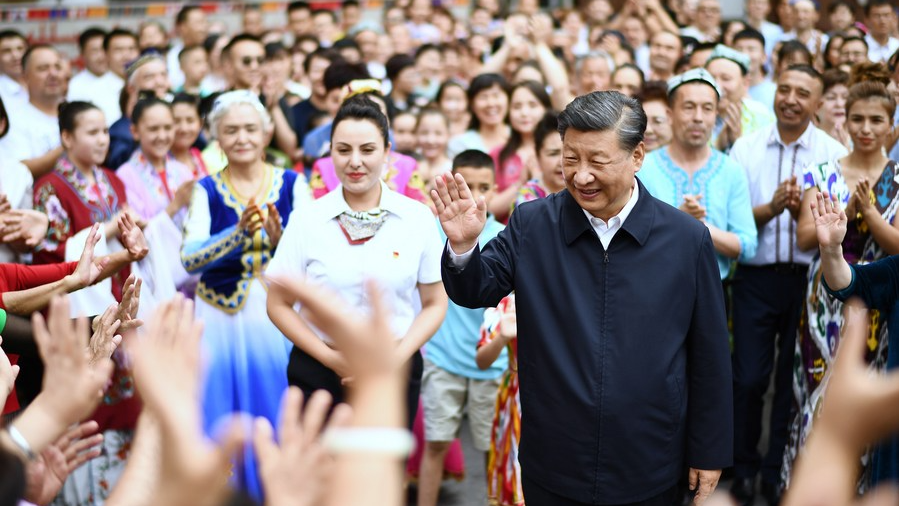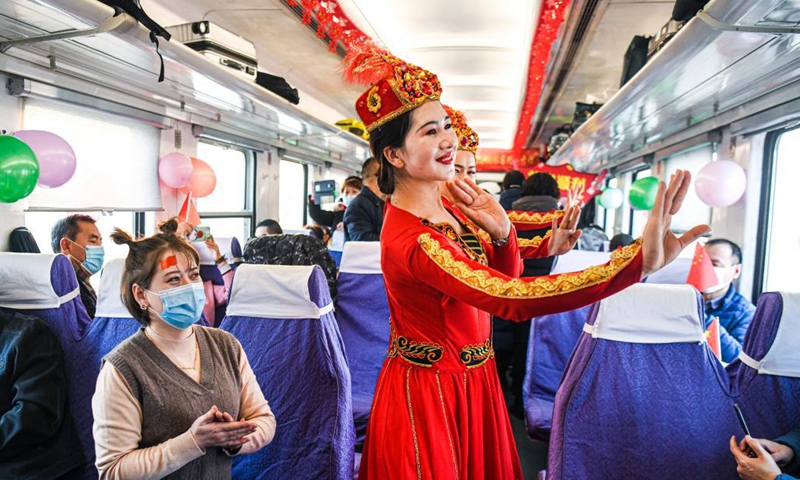
Chinese President Xi Jinping waves to people of various ethnic groups while visiting Guyuanxiang in Tianshan District of Urumqi, capital of northwest China's Xinjiang Uygur Autonomous Region, July 13, 2022. /Xinhua
Chinese President Xi Jinping waves to people of various ethnic groups while visiting Guyuanxiang in Tianshan District of Urumqi, capital of northwest China's Xinjiang Uygur Autonomous Region, July 13, 2022. /Xinhua
Editor's note: Gao Lei is an associate professor and research fellow at the Collaboration Center for Theories and Practice of Open Economy, Center for Xi Jinping Thought on Opening-up, Research Institute of Globalization and China's Modernization, University of International Business and Economics. Xia Lu is an associate professor at the School of Marxism Studies and research fellow at the National Academy of Development and Strategies, Renmin University of China. The article reflects the authors' opinions and not necessarily the views of CGTN.
Chinese President Xi Jinping completed his four-day inspection tour in northwest China's Xinjiang Uygur Autonomous Region, for his second time as leader of the country. He visited numerous institutions including the universities, local villages, urban communities, museums, cultural heritage sites, land ports, cotton and grape planting base, as well as the production and construction corps.
Xinjiang is the largest provincial level administrative region, bordering eight countries in Central and South Asia. President Xi said, Xinjiang is "a strategic pivot," channelling the East and the West, rather than "a peripherical area."
According to the Central Xinjiang Working Conferences, the three sessions of the national level decision-making and coordinating mechanism, have been held here since the turn of the new century, with the first one in 2010, second in 2014, and third in 2020. The common themes: Offering opportunities, seeking prosperity, promoting ethnic unity, forging national identity, and realizing stability.
Comprehensive development of Xinjiang is the main concern of the central leadership, including its economic growth and improvement of people's livelihood, as well as upgrading grassroots-level social governance and regional cultural development.
Bearing a very exotic atmosphere, Xinjiang is home to remarkable forms of art and delicious food that can be enjoyed by people nationwide. Numerous cultural heritages, tangible or intangible, which have been found in Xinjiang, even demonstrating the origins of cultural exchanges between the East and West, dating back to over 2,000 years ago.

Staff members and passengers dance together in train No. K9756 from Korla to Yetimbulak in northwest China's Xinjiang Uygur Autonomous Region, December 9, 2020. /Xinhua
Staff members and passengers dance together in train No. K9756 from Korla to Yetimbulak in northwest China's Xinjiang Uygur Autonomous Region, December 9, 2020. /Xinhua
Historical inheritance and geopolitical advantages explain why Xinjiang plays a crucial role in connecting the East and West via the Belt and Road Initiative (BRI). The China-Europe freight trains and newly established Urumqi International Land Port Area, have contributed to the region's transformation from a once under-developed hinterland to a rapidly growing one opening up to the outside world. The more open it is to the external world, the closer it is connected to the motherland; hence the more security and stability it would enjoy.
Additionally, the production and construction corps in Xinjiang, established after the founding of the People's Republic of China in 1949, and administered both as special troops militarily and state-owned enterprises economically, have shouldered important tasks, such as garrisoning the frontier while reclaiming the wastelands in deserted areas. They guard the gateways of China, while serving as environmental pioneers by curbing the spread of the desert, ensuring that Xinjiang has bountiful cotton and grape harvests.
A year ago during an inspection tour to Saihanba in Chengde, Hebei Province, President Xi highlighted the spirit of Saihanba, which has transformed a wasteland into a forest. A similar spirit has been instilled by the corps in Xinjiang, believing that the more livable a place becomes, the more stable it will be.
It has taken a long time for Xinjiang to emerge as as a vital bridge for the East and West and to serve as a stage where different ethnic cultures exchanges can integrate in cohesion. There's a common and broader identity encompassing all the elements to be incrementally forged – that is the Chinese nationality.
Scholars, who study modern Chinese history - once argued that for far too long some people had paid attention only to the distinctiveness of the region, without looking at other matters. That's inconsistent with historical scholarship.
Accordingly China wishes to fulfill the goal of rejuvenation of the Chinese nation, and the first step being the consolidation of the Chinese nationality as a cultural identity.
Therefore, President Xi says the top priority is the realization of ethnic unity and that's why he calls for forging a shared identity of the Chinese nationality. In terms of the rejuvenation, without uniting the people as a whole the goal cannot be accomplished as a whole.
(If you want to contribute and have specific expertise, please contact us at opinions@cgtn.com. Follow @thouse_opinions on Twitter to discover the latest commentaries in the CGTN Opinion section.)

